Last week, the ACBL expelled 2 pairs (Fischer-Schwartz and Fantoni-Nunes) after cheating allegations were proven beyond reasonable doubt. In practical terms that means that they are no longer a member of the ACBL and thus cannot play in (well paid sponsored teams in) any ACBL event. They can reapply for membership in some 10 years time, but there is no guarantee that this will be granted. The pairs also lose their titles and masterpoints won in the last 4 years. I’m not sure what will happen to these titles but that detail will no doubt be sorted out. Overall a good job by everybody involved in this from the ACBL.
Before you read on, two problems to think about.
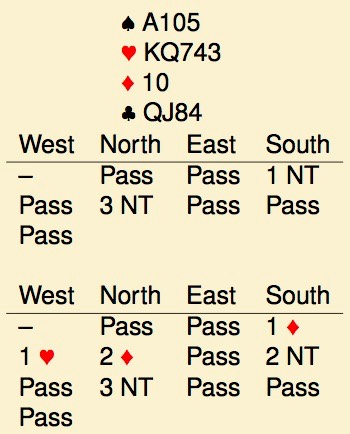
You are on lead twice with the same hand. First after a simple 1NT-3NT and second after a more revealing auction. 1NT shows 16-18, and the pair at the other table does play the same range but for some reason decided to open 1♦.
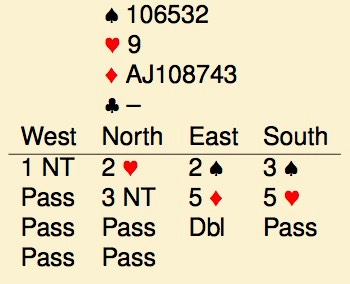
Second, 1NT showed a weak (12-16), balanced hand with 4 or 5 clubs and no other 4 card suit. Everything else was natural, with 3♠ showing spade values. Western Cuebids, the official name for asking for a stopper, had not been invented when this hand was played back in 1958. Your lead?
Cheating allegations have been around ever since the game exists. At the world championship level, the first serious one came up in 1958. I recently found a copy of the 1958 book on the event, albeit a reprint and not an original, so time to look back and do some fact checking.
The US team complained about too many inspired leads by their Italian opponents and suggested that the Italians had a way to illegally signal the location of aces, kings, singletons, voids and point-count ranges. That is a lot of information, even taking into account that screens were not in use. The Americans didn’t have any evidence how the information was transferred but suspected that it had to do something with hand-movements during the auction. At some point, they all signed a petition asking the WBF to investigate.
The Italian response was not unexpected: everything they did was kosher and the Americans were just poor losers. They had a point with the latter, the US considered themselves the number 1 bridge nation in the world but, after 4 wins in 1950-1954, they had lost the Bermuda Bowl final 3 teams in a row and were on the edge of defeat for a 4th time. If you are the strongest team, that cannot be true, right? The second option obviously was not considered.
The Italians nevertheless offered to hold their cards and hands under the table halfway through the tournament. That didn’t chance the end result: Italy simply won more imps than their opponents, they averaged about 6 imp’s per 16 boards more than their opponents. These are 1948 imp’s, which are harder to win than the current imp’s. For example: a vulnerable game bid and made at 1 table but not at the other, nowadays gains 10 imps (600-150, or 620-170, = 450). In 1958, you’d only win 7 imp’s. Also, the maximum on a board is 24 today but only 12 back then.
Why did the Americans felt that they were cheated. First of all, Al Roth, one of the US players, said that in the entire tournament he only once scored an overtrick. With the book, that is easy to check. 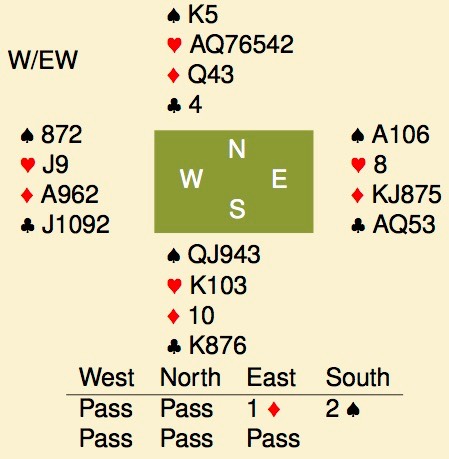 He and his partner played 120 boards and scored overtricks on 14 of them. The first overtrick came on board 16 but this wasn’t a success. The north hand looks like an opening bid to me, with arguments for both 1♥ and 3♥. 2♠ is described a decent hand, so I don’t understand the second pass from north either. 2♠ did score 140. In the replay, the Italian North opened 1♥, east made a take-out double which helped south to properly evaluate his hand and eventually 4♥ was reached. 10 tricks were scored, for a gain of 280 and (back then) only 4 imp’s.
He and his partner played 120 boards and scored overtricks on 14 of them. The first overtrick came on board 16 but this wasn’t a success. The north hand looks like an opening bid to me, with arguments for both 1♥ and 3♥. 2♠ is described a decent hand, so I don’t understand the second pass from north either. 2♠ did score 140. In the replay, the Italian North opened 1♥, east made a take-out double which helped south to properly evaluate his hand and eventually 4♥ was reached. 10 tricks were scored, for a gain of 280 and (back then) only 4 imp’s.
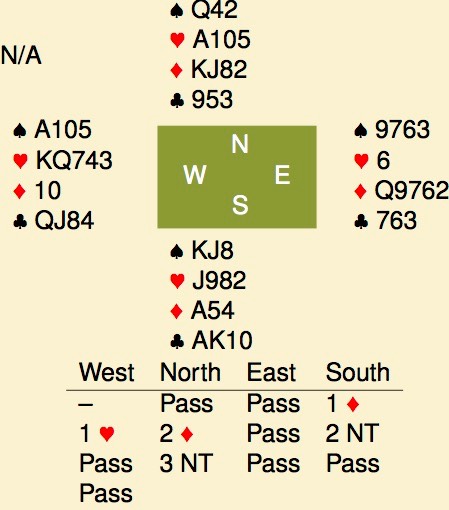
The first inspired lead. After 1NT-3NT, the best way to defeat the contract is obviously a small heart and I doubt that any expert would lead another suit. However, the Italian on lead led a club, and found partner with a singleton heart and 3 clubs. Almost 20 years later, the US declarer still called the club “A choice not a expert in a 100 would make”.
Back to the facts. The Italian declarer did lead in fact lead a club. The auction was different though, not 1NT-3NT but the one at the second table. Now a club lead is far more obvious, as the opponents have the hearts will stopped.
Of course, all this hardly matters, as 3NT is cold.
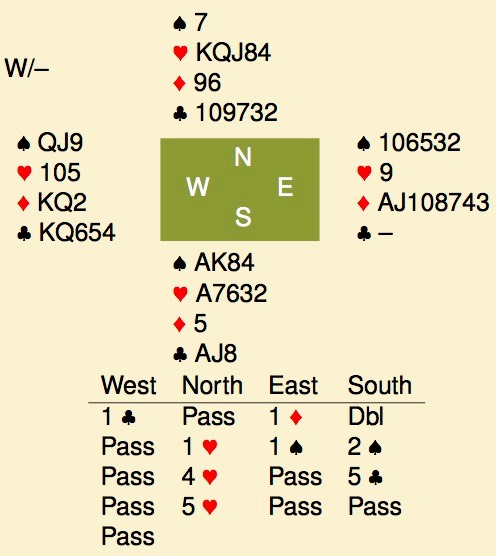
The second lead. This is a well-known theme in 2016 but was pretty new in 1958: In order to defeat the contract, you probably need a club ruff. That means that partner has to be on lead quickly. South has shown spade values, so it is quite reasonable to play partner for the ♦K and underlead your ♦A. Forquet for Italy actually did this, inspired yes, but something one can work out. Declarer now still had a club losers, for down one.
In fact, the US defender tried the same at the other table by leading the ♦A, no doubt with the intention to continue with a small one to the ♦K. Too late. I don’t quite understand this defense, west must have a couple of diamonds for his pass over south’s double, making it likely that north or south has a singleton or void.
After the ♦A lead, the hand is cold. East led the ♠3, declarer won the ♠K, drew two rounds of trumps ending in north. ♠A, ♠-ruff, ♦-ruff and a ♠-ruff. Now ♣10 endplaying west for the 11th trick.
The WBF never did anything with the petition, the ACBL later suspended a player for a few months because of the unfounded allegations. On the hands above, and more, the conclusion simply is that the Italians bid and played better. The US would have to wait another 12 years for their next Bermuda Bowl victory.
And finally a small request: if you like these articles, occasionally click on one of the ads below. That generates a bit of income for me and helps me to cover the cost of the site. You don’t have to buy anything, just a click will do.
